Tanner Goods: Contemporary American Heritage
Having the opportunity to speak to Tanner Goods, we gained a greater sense of the it’s background from their agency past to how a leather-based brand situates and looks to grow itself in the current landscape. Enjoy!
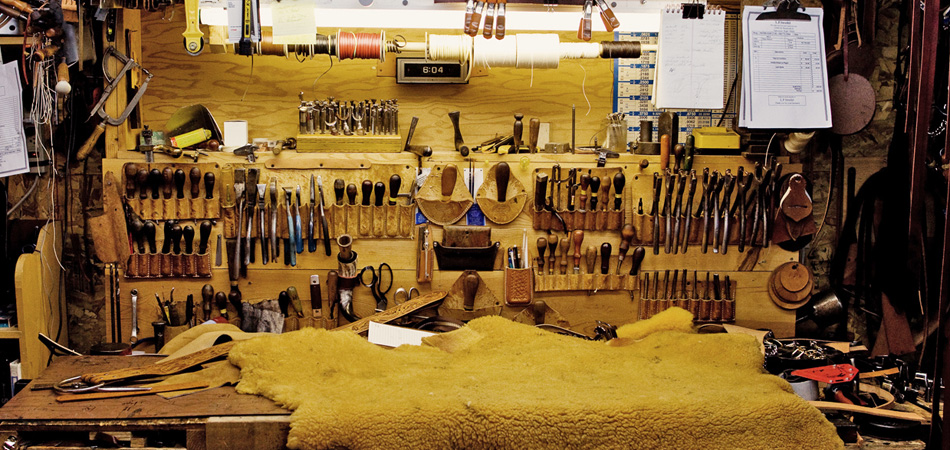
The last few years have brought an influx of up and coming American labels with their inspirations rooted in the past. Plying their trade with the utmost in artisan care and attention to quality, it has become an interesting intersection of America’s past and its production on a small scale. While some may lack the history and heritage of some of American’s most enduring brands, make no mistake, these brands such as leather outfit Tanner Goods are fully aware of their position and contributions involving quality, well-made goods. Having the opportunity to speak to the Portland-based leather brand, we gained a greater sense of the it’s background from their agency past to how a leather-based brand situates and looks to grow itself in the current landscape.
Interview: Eugene Kan
Photography: Patrick Richardson Wright
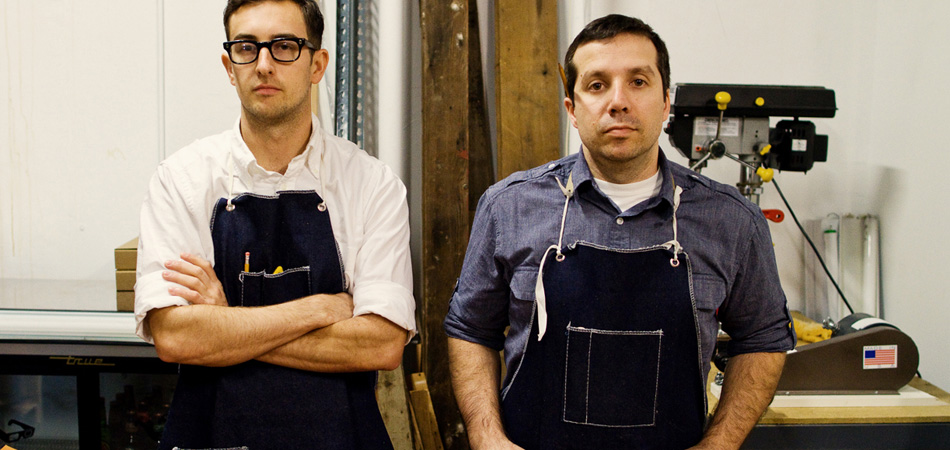
Hey Sam and Mark, as I understand you both used to work together? What exactly were your respective backgrounds before starting Tanner Goods?
Sam: I graduated with an Industrial Design degree and came to Portland to work for a design consultancy about 7 years ago. At the time Mark and myself were the only two designers working alongside both partners, so we formed kind of a partnership early on within the firm. It was sort of split down the line of ‘Old Guard’ vs. ‘New Guard’ which ended up working well for the firm when we went into client meetings.
The first project we worked on together was with Nike’s Innovation Kitchen. Our two styles complimented each other. I was more on the abstract, conceptual side of things and Mark was much more pragmatic… so when we started collaborating on projects together outside the firm, it was a natural fit.
Mark: I went to school for Industrial Design at Pratt Institute in Brooklyn, and studied Furniture Design for a semester in Copenhagen. My dad was our high school’s shop teacher growing up, so I was already pretty proficient when it came to building and construction. The time I spent in Denmark really sparked in me a broader appreciation for hand-crafted art and design, which eventually contributed to Sam and I starting Tanner Goods. I came out West after graduating and was hired as a designer at this small consultancy where I met Sam a year later, after he came on board.
So your initial project outside of your agency work came in the form of a Nike Innovation Kitchen collaboration? What exactly did it entail? As you continued work with the agency, when did you guys decide to branch off and start Tanner Goods?
Sam: The Innovation Kitchen job was actually our first project together at the agency. They brought me on right after Nike awarded it to them. Mark and I were out there last week for their Modern Craft exhibit, and unfortunately we’re still under a non-disclosure agreement that prevents us from getting into the details. It was pretty far out there in terms of concept, so I wouldn’t be surprised if it never goes to market. If anything, one of their in-line departments might absorb some portion of it and use it.
So yeah, that was the first time Mark and I teamed up for any kind of project. We ended up working on all subsequent jobs together at the agency, and then I left a year and half later. We had began working after hours on some bag and wallets, but it was more design and construction exploration than anything. I eventually started Tanner Goods on my own, and Mark came on as a partner when he left the agency a few months later.
Mark: TG really started as a response Sam and I had to working solely on mass-market goods. We were designing products produced in the thousands in a factory somewhere overseas, so this was our way of doing getting our hands dirty. Much of our inspiration came from early-mid 20th century manufacturing; patterns cut by hand, products assembled in a workshop using simple fasteners and durable stitch techniques. Like any craft or trade, we were really just trying to improve the quality and uniqueness of our product.
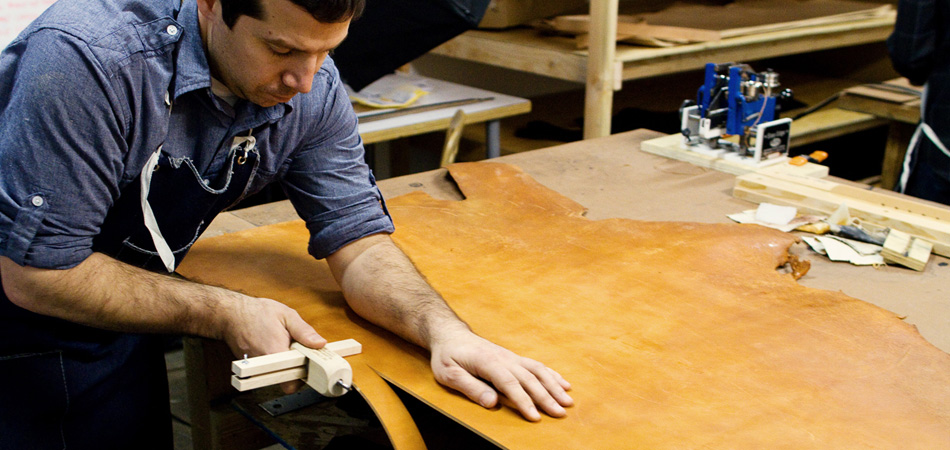
So what started as a simple side-project eventually blossomed into a full-fledged leather brand. Despite the ability to really step out and do things with creativity and innovation with your previous agency, do you feel that Tanner Goods was a whole new level in exploring and applying your inspirations? Also do you think Oregon’s surroundings had any impact on wanting to revisit this more artisan approach to craftsmanship? I would generally consider Oregon to be far from the usual hustle and bustle of other states across America.
Sam: The issue wasn’t that I didn’t feel fulfilled creatively, we were actually lucky that a majority of projects that came down the tube were highly innovative. For me it was more the fact that I’ve always enjoyed the fabrication of things. In an agency setting we would take a problem, conceptualize solutions, refine them, and then it disappears. There’s a whole side of building and constructing I was missing out on. So for me it was gratifying to be able to take an idea and then turn it into something tangible.
My roots in Oregon definitely had a hand in steering the type of products we focus on. I grew up in a small town in the Cascades where a lot of the economy revolved around craft trades: woodworking; coffee roasting; microbreweries; saddle makers, etc. I did an apprenticeship for a couple years in a pottery studio as a teenager, so I’m sure that helped develop my appreciation of craft.
Mark: Like Sam said, the consultancy we worked for was very creative and we did lots of conceptual projects. Some would see the light of day, but most others would disappear into a large corporate black hole. It was always a pleasure when we got a project that allowed us to make a prototype or study model – then all those hand-skills I acquired over the years came into play. I guess for me, I have always wanted to do my own thing, not just work for someone else and let them take the credit. By starting Tanner Goods, it allowed Sam and I to be creative on our own terms.
I have lived in many areas of the country, and by far the Northwest, Oregon in particular, has some of the most amazing and talented artisan and crafts people. The do-it-yourself ethos is huge here, and I feel we fit right in. My playground growing up was a four stall garage with a large metal and wood shop at my disposal. Portland is just another extension of that.
I see you, you guys have benefited from the strength of two movements as we’ve seen a great increase in respect and appreciation of products both made in the United States and from an artisan-approach. Some may see it from a few different perspectives, but to what extent do you think that there’s a symbiotic relationship between the two? That is, artisan goods pushing the made in America angle and the popularity of being “Made in America” enticing more brands to venture down this path?
Sam: That’s an interesting question. There’s a noticeable popularization of both, and they definitely play into each other… but my hope is that neither are reduced to a trending topic. I’ll say this, just because a product has the “Made in USA” label doesn’t always mean it’s of top quality. We are defined foremost by our skills and techniques as artisans, the attention to detail and meticulous finishing Mark and I dedicate to each product. That said, the “Made in USA” label is still very important to us as a brand. The English Bridle leather and waxed canvas we use is sourced domestically. Our manufacturing is done domestically. From top to bottom we are an American brand.
Mark: For us, there really was no compromise. We knew from the get go that we wanted to produce our goods locally by hand with a high attention to detail. As for the “Made in USA” ethos and the movement toward handcrafted goods, the economy has a lot to do with people buying American products. If you really think about it, people with limited means more often will spend a bit more on an item that will last for years rather than pay less for junk. It’s also a matter of people wanting to put money back into the economy, both on a local and domestic level.
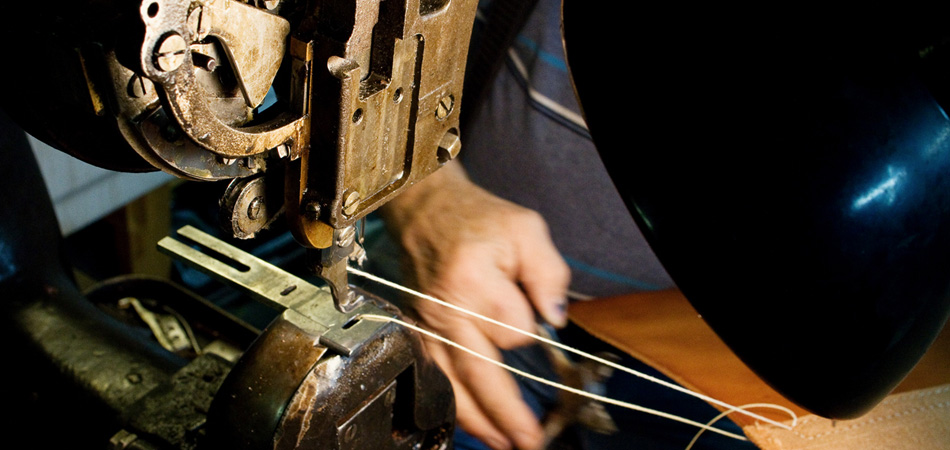
Do you think that a welcome by-product of difficult economic times is that there has been a shift towards more quality products and less fast/consumable pieces. Is this here to stay? When things return to a similar economic state of a few years ago, will people be less likely to revert to their old ways. Surely this must mean that the opportunity for growth with Tanner Goods is quite promising.
Sam: I think if anything the economy has introduced us to a new demographic. Younger folks, in my opinion, tend to consume at a faster rate. To some extent they drive the speed at which trends turn over, and maybe in the past weren’t as concerned with buying a product they could keep in their closet for more than a couple seasons… but the economy changed that. So yeah, I think on some levels the perceived value of goods like ours is here to stay. It might not be as strong a few years down the line, but things have definitely shifted.
Mark: I do think that the type of person who is buying Tanner Goods is going to be around for awhile. This economy has shown how resilient people can be and how their buying habits have changed for the better. What I mean to say is that people are making more educated choices, purchasing well made goods that will last.
While there’s a certain timeless aesthetic with many of the products released by Tanner Goods, down the road, how do you envision keeping the brand progressive? Or based on your philosophy and inspirations, timeless design, colors and material choices have in some ways created a pre-destined path for the brand?
Sam: Right now we’re known as a belt company first and foremost. That’s our staple product, and will always be a mainstay in our collection. But our design language and material choices translate well to other categories, and Mark and I have a pretty detailed list of goods we’d like to offer down the road. I think whether it’s a boot, a duffle bag, or even a pair of eyeglass frames, our philosophy makes sense. For us it’s just a matter of taking the time to dial in each offering and making sure the design, construction, and aesthetic is right.
Mark: From the start we wanted to create something that could grow organically. The “Goods” in Tanner Goods was very deliberate , allowing us to translate our craft and skills into different areas of product. Leather itself has a timeless quality inherent to the material. If we can blend those elements to other offerings and create well constructed products, Tanner Goods will continue to push in many new directions.
While terms such as “Japanese Denim” have signaled that certain materials can become synonymous with a region based on positive traits, do you think that with your help, the term “American Leather” can become a desirable trait (if it hasn’t already been established)? What’s the current American leather industry like and what changes would need to be made to cement America’s position as a high-quality leather purveyor?
Sam: The leather industry in the United States is a lot smaller than people realize, which is a benefit. Globalization moved a lot of the textile and leather industries to Asia and South America where cost is most important, so what we were left with was a handful of outfits that specialize in high end, quality leather. This notion that American tanneries are producing the most premium leather has only been reinforced by the growth of brands like ourselves, Yuketen, Alden, and Quoddy.
Mark: I think one of the biggest issues with the leather industry, foreign and domestic, has been environmental impact. There was a large movement in the US away from traditional vegetable tanning and towards chrome tanning during the past century. This led to a lot of negative environmental impact and spurred the US to tighten regulation and environmental policy. In a roundabout way it helped return the American leather industry to more traditional processes for tanning leather, and cemented it as one of the top producers of English Bridle leather.
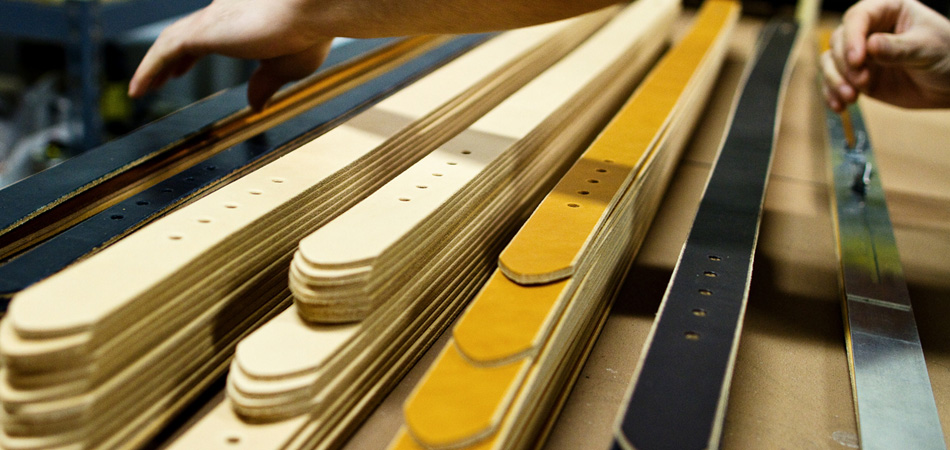
In general, do manufacturing processes in a more old-school approach yield a more environmentally friendly product? I would assume that at times it may be more inefficient but does the “contemporary” heritage-inspired brand owe it to themselves to incorporate environmentally sustainable practices into their protocol at the cost of authenticity.
Sam: A lot of the old-school techniques are inherently environmentally friendly, vegetable tanned leather doesn’t produce the harsh byproducts chrome tanning does. For us, the most environmentally responsible practice we do is keeping things close to home. Our leather doesn’t have to travel far to reach our studio, and we produce things by hand, not in a factory overseas. Materials and product don’t have to be shipped thousands of miles. It’s very similar to the idea of localization that restaurant and grocery industries are implementing.
Mark: One of the attractions to using leather is sustainability. We’re essentially taking a waste product from the beef industry and turning it into a valued good. Re-purposing this material into something with a lifespan measured in years instead of months is intrinsically sustainable.
Beyond that, these old hand-crafted processes for manufacturing have very little impact on the environment. What we sacrifice is the economy of scale, we can only make so many labor intensive items by hand compared to a large scale factory. If you look back at those original heritage brands, you would find that they were all on the cutting edge of domestic industrial manufacturing for their time. But as demand grew, they moved overseas to keep increasing efficiency and lowering cost.
Sam: That’s a road some contemporary brands will also choose, and I do think some authenticity is lost. We’re very aware of the limitations in how large we can grow based of our practices, and we’re totally fine with that. We’ve chosen a different business model.
We’ve seen you partner with select brands who have utilized your leathers as accents to their products such as the tag on denim. But going forward, do you have any desire to partner with more brands who share similar visions to create items outside of your current roster of belts and accessories.
Sam: Yeah, definitely. There are so many products out there that utilize leather, whether it be a primary material or trim… it creates a lot of potential partnership opportunities. I wouldn’t be surprised to see some of the larger players like Woolrich, Filson, and L.L Bean focus more on using American leather for their trims. It’s a compelling story to tell, especially for brands that have an American heritage history.
Aside from trims, there are the obvious partnerships – working with a boot company or bag manufacturer… but what really intrigues me is the possibility of making a knife sheath or hatchet cover. Something a little more unexpected. I’d love to do a Tanner Goods watchband for example, it’s just a matter of finding a partner that is the right fit.
Mark: Furniture is another avenue we’ve been talking about lately. Being that Sam and I have backgrounds in industrial design, there are a lot of niches we’d like to explore down the road. But again, it all depends on timing and producing something compelling.
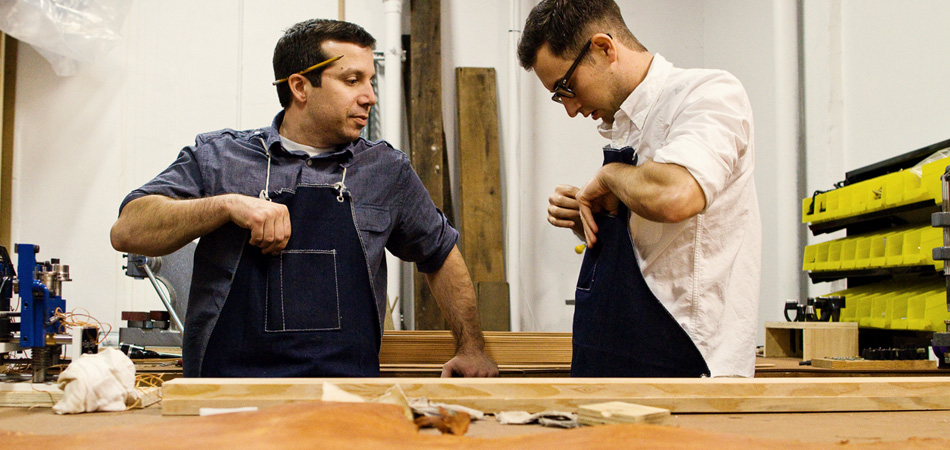
Typically most items from Tanner Goods are quite simple and utilitarian in their design. Often what’s your process? Do you conceptualize a product and then choose the leather or is it sometimes the other way around (or maybe nothing along those lines at all?).
Sam: Most of our goods are cut from the same style of leather, English Bridle, but they vary in weight depending on the intended use. Mark and I generally start with a concept and make half a dozen rounds of samples and put them to use. We’ll come back and discuss certain elements we like or dislike, and make the appropriate changes. Even though our designs are clean and simple, a lot of thought is put into size, dimension and usability. In the end we’re aiming to make a product that speaks to a consumer who appreciates an honest product, not one with a ton of extraneous pockets or embellishments they won’t use. We’re definitely subscribers to the “form follows function” ideal.
Mark: Inspiration for a large portion of the designs come from our own personal needs, say a card holder Sam is interested in making or a tether that I wanted to secure my wallet when I’m on my motorcycle. We usually construct the wallets and bags around their purpose and we do many revisions to get it right. Then comes the fun part, using the product. This generally takes a few months before we’re comfortable releasing it to the public. Sam and I are very particular about what works and what doesn’t, and won’t put the Tanner Goods makers mark on it until its right. We respect our customers’ need for a functional product, just the same as we do.
It’s been argued that a lot of the American heritage brands without their own hundred year old history have mainly been inspired by what the Japanese have been doing the last few years with their own Americana appropriations, do you have any particular thoughts on this? Or do you feel even if it’s the case, the irony of it all doesn’t necessarily need to be reflected or focused on?
Sam: I think you could make the argument that even the heritage brands WITH a lengthy history are taking inspiration from Japan. It’s one of those snake eating its own tail scenarios, can you really call out a heritage brand for taking inspiration from a Japanese brand who did a reproduction of something they were doing 50 years ago? I don’t think you can. If anything, it’s sparked these companies to take a closer look at where they are now compared to where they started out. In essence, it has forced them to examine how they might recapture some of their original vision.
And on a larger level, interest here in the states with Japanese Americana has helped build an appreciation among US consumers for their own history. That’s played a huge role in helping boost this resurgence. It’s ironic on many levels, but I think it will eventually lead to some new direction in design. Seeing how other parts of the world, like Scandinavia for example, reinterpret the Americana aesthetic is particularly interesting.
Any upcoming projects and last words?
Sam: There’s a handful of projects we’ll be releasing sporadically outside of our normal product line… an exploration of sorts into some of the markets Mark and I mentioned earlier. We also have some new items we’ve been developing with 3sixteen later on this year. I have to give props to both Andrew and Johan, they’re two of the most solid guys we’ve been fortunate enough to work with. I also have to say thanks to the rest of our small family, Mike for contributing in so many ways I can’t even list. Meghan, Jevan, and Casey for their continued inspiration, hard work and support.
Mark: Just wanted to say thanks for all the people that have supported us since the inception of Tanner… Mike for all the extra time you put in. Also for the opportunity to share our small story with HYPEBEAST readers. Sam and I will be releasing many new products in the coming year as well as venturing into new territory for us as a brand. I’ll leave it at that, don’t want to spoil the surprise!
